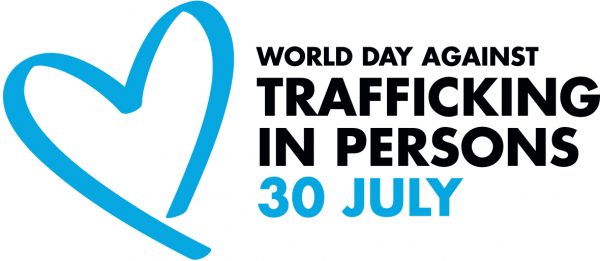Every year, millions of children, women and men fall into the hands of traffickers, lured by fake promises and deceit. Human trafficking has become a global multi-billion-dollar enterprise, affecting nearly every country in the world. Today, there are millions of people whose liberty, dignity and essential human rights have been stolen. They are coerced into sexual exploitation, forced labour, domestic servitude, forced begging and stealing, and even compelled to “sell” skin and organs.
In 2013, the General Assembly held a high-level meeting to appraise the Global Plan of Action. The Member States also adopted resolution A/RES/68/192 and designated July 30 as the World Day against Trafficking in Persons. This resolution declared that such a day was necessary to “raise awareness of the situation of victims of human trafficking and for the promotion and protection of their rights.”
Human trafficking is a crime that exploits women, children and men for numerous purposes including forced labour and sex. The International Labour Organization estimates that 21 million people are victims of forced labour globally. This estimate also includes victims of human trafficking for labour and sexual exploitation. While it is not known how many of these victims were trafficked, the estimate implies that currently, there are millions of trafficking in person victims in the world.
World Day against Trafficking is an internationally-recognized day, set apart to bring attention to trafficking; a grave violation of human rights that undermines global stability. Over 45 million people are estimated to be trafficked or forced into labour around the world, with women and girls comprising 71 percent of all victims.
Trafficking in Person: A Global Malady
People trafficking and modern day slavery is a massive worldwide problem with very few countries immune to human trafficking, and the event by the United Nations is to raise awareness and increase prevention of that. Every country in the world is affected by human trafficking, whether as a country of origin, transit, or destination for victims. Children make up almost a third of all human trafficking victims worldwide, according to the United Nations Office on Drugs and Crime Global Report on Trafficking in Persons. Additionally, women and girls comprise 71 per cent of human trafficking victims, the report states.
In 2010, the General Assembly adopted the Global Plan of Action to Combat Trafficking in Persons, urging Governments worldwide to take coordinated and consistent measures to defeat this scourge. The Plan calls for integrating the fight against human trafficking into the UN’s broader programmes in order to boost development and strengthen security worldwide. One of the crucial provisions in the Plan is the establishment of a UN Voluntary Trust Fund for victims of trafficking, especially women and children.
The United Nations Voluntary Trust Fund for Victims of Trafficking
The Trust Fund facilitates effective, on-the-ground assistance and protection to victims of trafficking, through grants to specialized NGOs. In the coming years, it aims to prioritize victims coming from a context of armed conflict and those identified among large refugee and migration flows. It will also focus its assistance to victims trafficked for the purpose of sexual exploitation, organ removal, forced begging, forced criminality and emerging exploitative purposes (e.g. skin removal, online pornography).
In September 2015, the world adopted the 2030 Sustainable Development Agenda and embraced goals and targets on trafficking in persons. These goals call for an end to trafficking and violence against children; as well as the need for measures against human trafficking, and they strive for the elimination of all forms of violence against and exploitation of women and girls. Another important development is the UN Summit for Refugees and Migrants, which produced the groundbreaking New York Declaration. Of the nineteen commitments adopted by countries in the Declaration, three are dedicated to concrete action against the crimes of human trafficking and migrant smuggling.
WDAT 2019: ‘Responding to the trafficking of children and young people’
Thousands of men, women and children end up in the hands of traffickers every year, often through being tricked and mislead to believe that they are being taken to work that will make their family better off, or through force, kidnap, or even through very poor families selling children in order to survive. There are many ways that people get caught up in trafficking, but the result is the same, they lose their rights and identity and are used and abused, and it is a global problem, an industry not far behind drugs and arms in terms of profit for traffickers.
This year, the United Nations Office on Drugs and Crime (UNODC) has chosen ‘responding to the trafficking of children and young people’ as the focus of the World Day. This year’s campaign highlights the fact that almost a third of trafficking victims are children. The theme draws attention to the issues faced by trafficked children and to possible action initiatives linked to safeguarding and ensuring justice for child victims.
Sources
UN
UNODC
CFR
Featured Image Source: unodc.org


